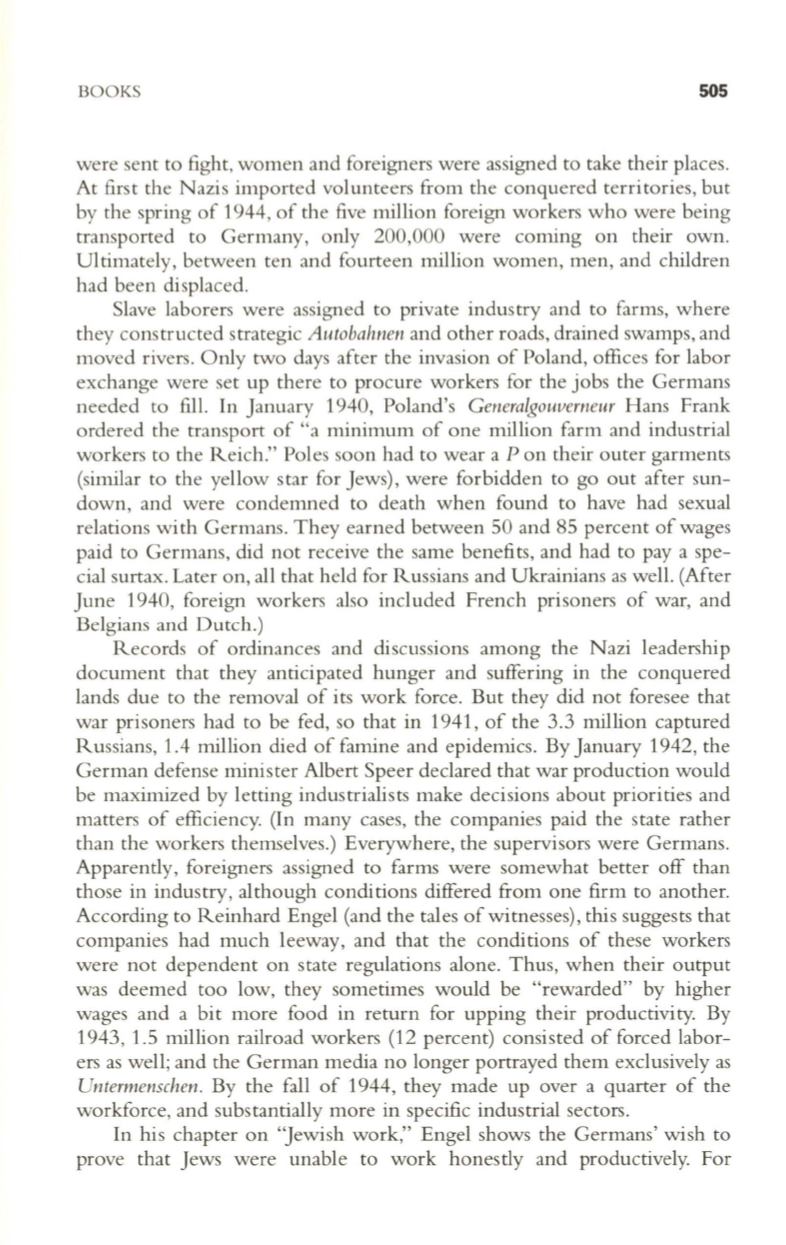
BOOKS
505
were sent to fight, women and foreigners were assigned to take their places.
At first the Nazis imported volunteers from the conquered territories, but
by the spring of 1944, of the five million foreign workers who were being
transported to Germany, only 200,000 were coming on their own.
Ul timately, between ten and fourteen million women, men, and children
had been displaced.
Slave laborers were assigned to private industry and to farms, where
they constructed strategic
Autobahnen
and other roads, drained swamps, and
moved rivers. Only two days after the invasion of Poland, offices for labor
exchange were set up there to procure workers for the jobs the Germans
needed to fill. In January 1940, Poland's
Generalgouverneur
Hans Frank
ordered the transport of "a minimum of one million farm and industrial
workers to the Reich." Poles soon had to wear a
P
on their outer garments
(similar to the yellow star for Jews), were forbidden to go out after sun–
down, and were condemned to death when found to have had sexual
relations with Germans. They earned between 50 and 85 percent of wages
paid to Germans, did not receive the same benefi ts, and had to pay a spe–
cial surtax. Later on, all that held for Russians and Ukrainians as well. (After
June 1940, foreign workers also included French prisoners of war, and
Belgians and Dutch.)
Records of ordinances and discussions among the Nazi leadership
document that they antici pated hunger and suffering in the conquered
lands due to the removal of its work force. But they did not foresee that
war prisoners had to be fed, so that in 1941, of the 3.3 million captured
Russians, 1.4 million died of famine and epidemics. By January 1942, the
German defense minister Albert Speer declared that war production would
be maximized by letting industrialists make decisions about priorities and
matters of efficiency. (In many cases, the companies paid the state rather
than the workers themselves.) Everywhere, the supervisors were Germans.
Apparently, foreigners assigned to farms were somewhat better off than
those in industry, although conditions differed from one firm to another.
According to Reinhard Engel (and the tales of witnesses), this suggests that
companies had much leeway, and that the conditions of these workers
were not dependent on state regulations alone. Thus, when their output
was deemed too low, they sometimes would be "rewarded" by higher
wages and a bit more food in return for upping their productivity. By
1943, 1.5 million railroad workers (12 percent) consisted of forced labor–
ers as well; and the German media no longer portrayed them exclusively as
Untermenschen.
By the fall of 1944, they made up over a quarter of the
workforce, and substantially more in specific industrial sectors.
In his chapter on "Jewish work," Engel shows the Germans' wish to
prove that Jews were unable to work honestly and productively. For


